You are using an out of date browser. It may not display this or other websites correctly.
You should upgrade or use an alternative browser.
You should upgrade or use an alternative browser.
Russian Military News, Reports, Data, etc.
- Thread starter tphuang
- Start date
war economy and mobilization.declare war? which entails russia do what that she is not doing already?
that would be an admission russia blundered into the conflict grossly underestimating the opponent.
However at this stage, that may be the only step russia can take to definitively prevent a outright loss on ukraine.
However at this stage, that may be the only step russia can take to definitively prevent a outright loss on ukraine.
delete, not getting sucked into off topic.
I will not put any stock on Peshkov statements.I think this report about a possibility of declaring formal war has being taken from here:
"Kremlin spokesman Dmitri Peskov:
“If Ukraine continues its provocations by attacking Russian cities, Russia will be forced to declare war against Ukraine”.
The fact is already close to 20,000 sorties excluding choppers. and presumably closer to 2000 missile launches. so what else is not a war in post Covid enviroment. hyper efficient societies like Japan and Germany cannot maintain industrial efficiency.
I dunno how much we can take from that sim though.Interesting sim on the Moskva sinking.
Anyone able to shed any light on the finding that high waves prevented missile launch from the cruiser due to sea clutter interference.
Recall the entire reserve and put far more resources into the conflict. It probably changes the ROE and the scope of the operation. Also, switch the economy to a war footing, as well.declare war? which entails russia do what that she is not doing already?
that would be an admission russia blundered into the conflict grossly underestimating the opponent.
At this point, it is obvious they blundered. They probably also underestimated how much the US was willing to commit and push the other side.
Last edited:
Question for all have we seen in the field samething near the version below ???
Interesting sim on the Moskva sinking.
Anyone able to shed any light on the finding that high waves prevented missile launch from the cruiser due to sea clutter interference.
Normally the early warning radar onboard would have been able to filter out most of the clutter using MTI processing. and separate fast moving target from it. The thing is that, Earth is not flat while missiles can fly low. The Moskva have Earth working against her. The following is coverage of her radar.
The legend is at lower right of the image. The green circle depicts coverage of her Top Pair radar against target flying at 7 m ASL, Yellow is 10 m while Orange is 40 m, Red 500 m and Blue is conventional aircraft altitude.
in my previous post i said that Neptun may share similar feature as Uran of being able to go sea-skimming as low as 4 m. and i argued against this as when she was attacked the sea state was high about 6-7 where wave might hit the missile. But that doesn't mean the missile can't be set to fly bit higher yet still offer lowest chance of detection. tho i dont really know if such setting exist.
Notice that for sea skimming target, her coverage is -Less- than 50 Km. The earliest opportunity to detect however would rise when the missile "pitch up" to search and lock on target before dive in again back to sea skimming phase. This might occur somewhere in 50 km.
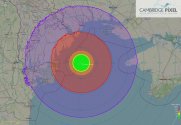
The detection range, at least from what i gather from Janes for MR-500 is about 200 Km for fighter sized target. In S-band. Which correspond to RCS of 2 sqm. At the moment i have no model of Uran or Neptun but from my modeling on other type of conventional subsonic missile. RCS as low as 0.048 sqm can be expected in S-band for a small conventional axisymmetric airframe anti ship missile in frontal aspect. Which looks something like this in graphics.
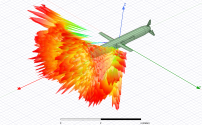
Using 4th Root rules for that value of RCS and with the established figure for the Radar yielded detection range of 75.2 Km. But as demonstrated the coverage against sea skimming target is NOT that far. The earliest possible detection range would be less, maybe 50 or 40 Km and only for few seconds as the missile needs only short amount of time to get a lock and fix its INS.
Is that all ? No Her problem is not finished yet. It has another thing working against her namely Path propagation factor. Earth is not only flat but also have soils and waters, These materials AFFECTS propagation of radar wave, other than creating clutter the wave will also interact with the materials and creates interference. If you ever see Range-Height coverage diagram of a radar, you would see that it is lobing like this
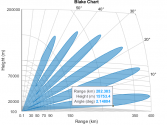
Target flying at certain altitude may end up being in the "null" of the lobe and thus undetected. Modeling it is complex but there is simple model which takes account on a simple smooth reflective surface which similar as sea-water. The smoothness here is depending on the wavelength of the radar NOT what visually observed. The equation is as follows :
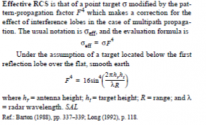
The modeling result in an path propagation factor which can then Multiplied by "free space" RCS calculated earlier to yield "Effective RCS" This effective RCS is the RCS of the target taking account of the path propagation factor.
Now let the flight altitude be 50 m and range is some 50 km, The altitude where Neptun probably climb to search for target.
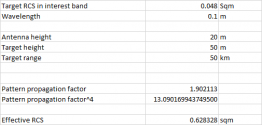
The Effective RCS is 0.6 sqm Thus Moskva might get early detection of the missile at that range, But if the missile only takes like few seconds to get a lock and go back to sea skimming phase, the operator would probably considered the missile as false contact or bird.
Once the missile got back into Sea skimming. It essentially undetectable due to Path propagation advantage, as depicted here.
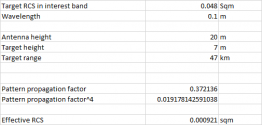
Notice at 7 meter sea skimming. The missile's Effective RCS drops so much. She will not stand a chance to detect the missile.
This is why Surface scan radars are mostly in X or C band. as those bands have propagation advantages. It may still lost low altitude contact but can quickly regain it. Something of lower frequencies like S or L doesn't have. They're more suited for high-medium altitude area defense.
Hope my explanation make sense.
A fundamental weakness of this "analysis" is the assumption that the ship was operating alone. Even if some of its radar systems were down for scheduled radar maintenance, there would be other ships in the theater to provide cover.Interesting sim on the Moskva sinking.
Anyone able to shed any light on the finding that high waves prevented missile launch from the cruiser due to sea clutter interference.
Another factor not considered is that high sea states might have impaired the ability to launch missiles and fire guns to a much larger degree than the ability of radars to detect and track the incoming missile. Makes me wonder if cold launch is more likely to be impaired in high sea states due to the relatively lower ejection speed compared to hot launch?
Last edited:
